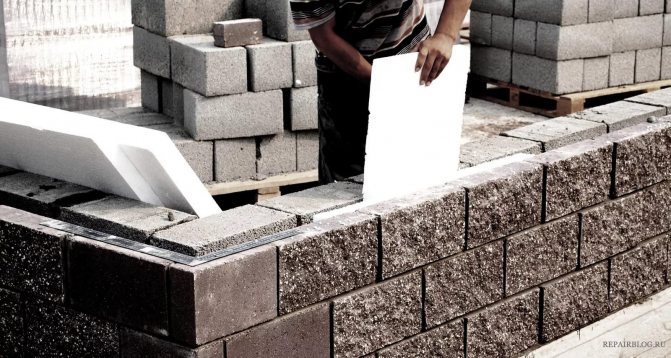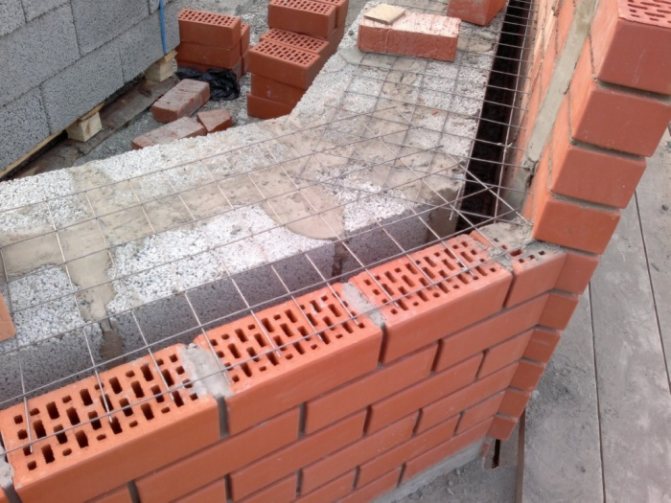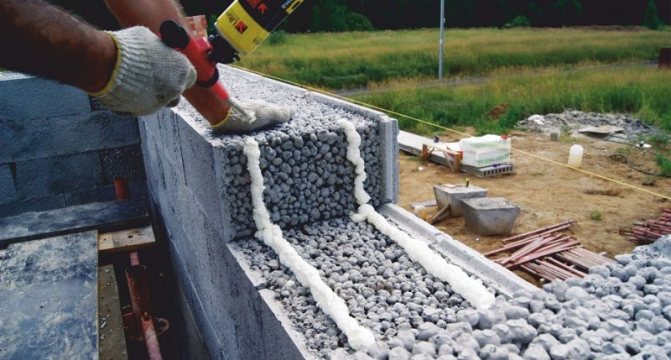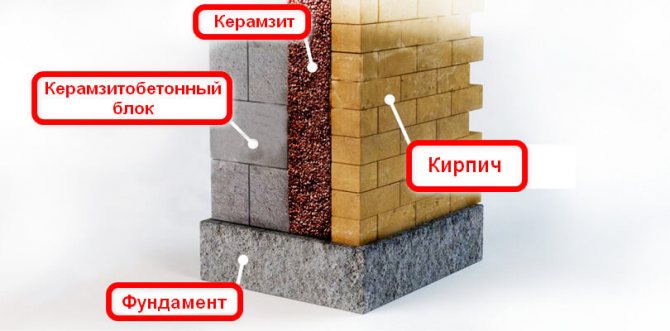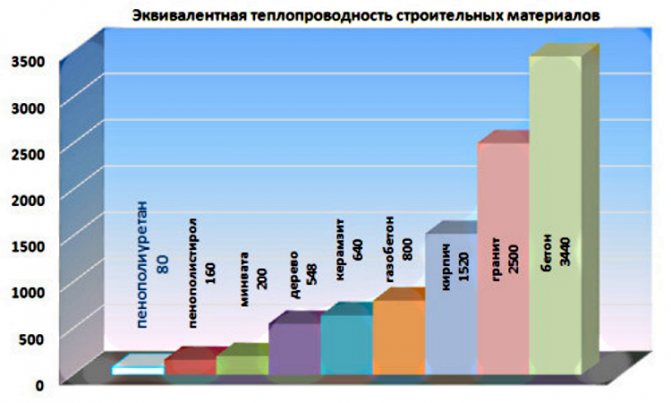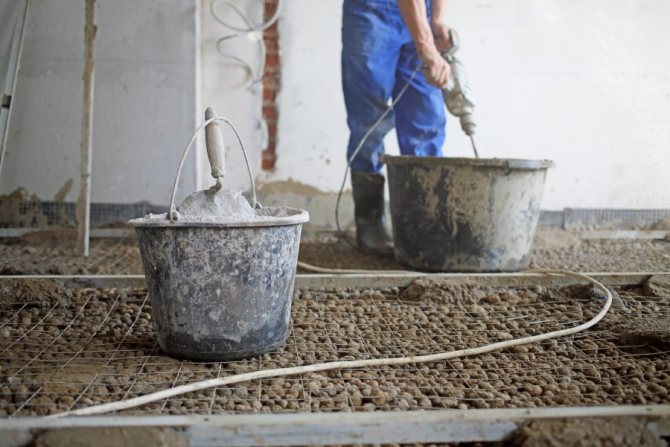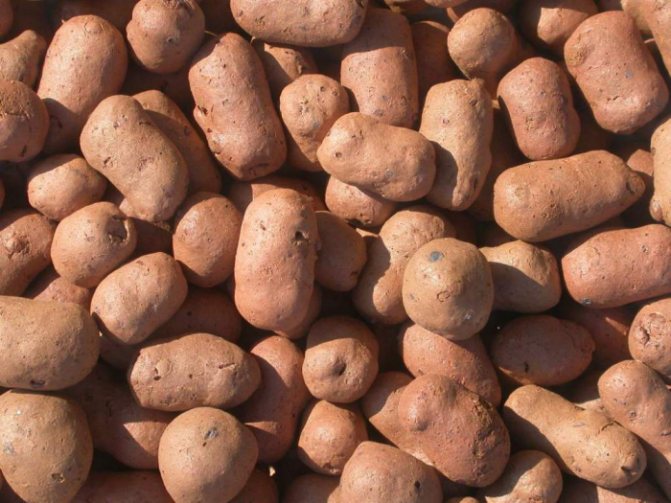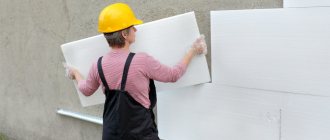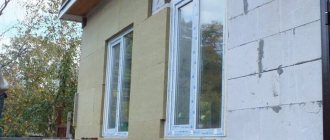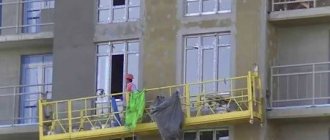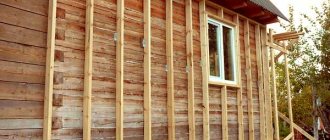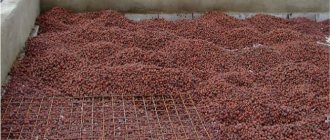Today, one of the most demanded materials in the construction industry is expanded clay concrete.
A house made of expanded clay blocks can have any architectural style and look attractive both inside and outside.
The advantages of expanded clay blocks are:
- light weight and low load on the foundation (expanded clay weighs half as much as brick);
- excellent vapor permeability (walls breathe);
- high strength;
- quick installation;
- immunity to mold and mildew;
- low cost.
Expanded clay: what is it?
This building material is a fairly light granules with small pores. They are obtained by firing clay. It can be used both in private houses and in standard apartments located in high-rise buildings. Expanded clay is environmentally safe for human health, as it does not contain synthetic additives and harmful substances that can harm and lead to harmful consequences. It allows air to pass through well, which prevents moisture condensation. Expanded clay insulation (people's reviews allow us to judge its quality), first of all, has good thermal insulation. It also acts as a sound-absorbing and refractory material. It has a high level of frost resistance and is not destroyed by temperature fluctuations. The service life of expanded clay is quite large, in this indicator it has no equal among other materials. It is worth noting that this insulation is not at all afraid of prolonged interaction with hot and cold water. Therefore, there is no need to be afraid that after the flood you will have to completely change the subfloor.

Insulation material
Any insulation from the following list will be good thermal insulation of expanded clay blocks:
- Styrofoam;
- expanded polystyrene (penoplex);
- glass wool;
- mineral wool.
Glass wool is used traditionally and widely. She is not afraid of moisture, frost-resistant, holds air well. Its serious drawback is its environmental hazard. This is an insulation material that poses a serious health hazard during installation or repair work. Unfortunately, builders do not consider this a disadvantage (if it is not about their own home).


Mineral wool is similar to glass wool in many ways. It is also, like glass wool, an inorganic, persistent heat protection agent, with parameters close to it. Mineral wool is made from basalt or metallurgical slag. For health, mineral wool poses less threat, as it does not form too thin and invisible fibers. Mineral (stone) wool is more expensive than glass wool.
Expanded polystyrene is close to polystyrene in its heat-shielding properties, but it has an undoubted advantage over polystyrene - it is not afraid of rodents. Therefore, there is no additional cost to protect the material from the access of these animals. At the same time, the cost of expanded polystyrene is higher than that of expanded polystyrene.
Types of expanded clay
Expanded clay as insulation is used quite often in construction. However, you need to know that, depending on the scope of application, it is necessary to choose a certain type of material. Typically, there are three main varieties.
The first, sand, is most often added to dry mixes, which are intended to be applied to surfaces in order to create an insulating layer. The maximum size of its granules is 5 mm. Also, this type can be used to create a heat and sound insulation cushion, which is rammed under the main covering.
Please note: a 15 cm layer saves 50% on heating costs.
Expanded clay, as a heater (reviews are mostly only positive), in the form of granules is used not only for floors, but is also widely used for roofs and ceilings. Owners of private houses prefer this faction when it comes to the attic or attic.
Expanded clay in the form of crushed stone is finely crushed gravel. The sizes of the grains are different. Thanks to this, the compacted layer is as functional as possible. Consumer reviews give the right to judge its high quality and properties. Perfectly copes with its main purpose, even in the coldest rooms.
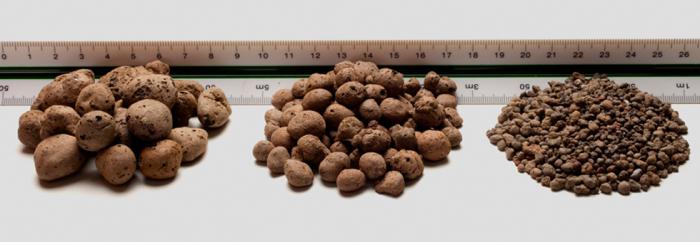

How to insulate the ceiling with expanded clay?
Insufficient insulation of the ceiling during the construction of an object can result in significant heat loss during its operation. To prevent such a development of events, installation of insulation to the ceiling or attic base will allow. Of the variety of insulating materials on the market, the most popular for decorating ceiling structures are foam, mineral wool and expanded clay. At the same time, granular bulk insulation, in addition to high efficiency, also provides real financial savings.


At the initial stage of insulation work, layers of moisture and vapor barrier are laid. These are roll materials presented in the form of foil, roofing material or ordinary plastic film. They can be self-adhesive or installed using a simple technology: the material is laid out on the floor, marked in accordance with the dimensions of the insulated surface and cut out according to this marking. Each strip of waterproofing should extend onto the beam by about 10 cm.
If the area of the insulated ceiling is too large, the strips should be installed with an overlap of about 10 cm. A special construction tape is used to seal the joints. In a wooden room with high humidity, ceiling insulation is carried out with the obligatory installation of waterproofing for the chimney and beams. For this purpose, strips of material are attached above a layer of expanded clay.
Soft clay is laid on top of the moisture protection, after which the main insulation is installed (for expanded clay, the layer thickness should fluctuate within 10 - 16 cm).
It is advisable to form expanded clay backfill for roof insulation from granules of different calibers. This approach will make the coating as dense, uniform and lightweight as possible.
Properties of expanded clay as insulation
The main indicator of this material is the natural clay composition. After high temperature processing, it becomes quite durable and reliable. It is worth noting that by using it in garages and basements, you can forget about such a problem as rodents. With an average cost, it has a long service life. And in comparison, for example, with a tree, it wins significantly, since it does not rot, does not create a favorable environment for insects, is not at all afraid of moisture and even a long stay in water.
The properties of expanded clay, as a heater, are multifunctional both in winter and in summer. It is considered the most versatile material that has a high level of frost resistance and copes well with exposure to high temperatures.
The main property of this material is the complete absence of toxicity. Also, importantly, expanded clay does not create a favorable environment for mold, fungus and other pathogenic bacteria. Due to the fact that it does not enter into chemical reactions with aggressive substances, such a coating completely eliminates the likelihood of the formation of harmful vapors that can adversely affect human health.
Scope of expanded clay
The scope of this material is quite large. First of all, it is a common material for floor insulation.It is in this place that it is considered the most ideal and financially acceptable. But for comparison: expanded clay as wall insulation (reviews help to conclude that this method is unprofitable) is rarely used. Some might say that manufacturers have now developed special underfloor heating. And so it is. However, their cost is quite high, which makes this option practically inaccessible. But expanded clay, on the contrary, is easy to install and at a price is suitable for any family with an average income.
Depending on the base of the floor, the appropriate insulation method is selected:
- Reinforced concrete floors. It is recommended to additionally mount a vapor barrier layer on such a surface, which will prevent moisture penetration. After that, the base is poured with a special solution obtained by mixing concrete with expanded clay.
- Warming of the foundation is carried out both outside the structure and inside. To obtain the maximum result, it is necessary to qualitatively fill all the voids.
- Expanded clay as a floor insulation in a wooden house is the most effective. This method will allow not only to reduce heat loss, but also to extend the operational life of the coating.


Wall insulation with expanded clay is also used in construction. Basically, this method is acceptable in newly erected buildings. It consists in using a certain three-layer method, where the main layer consists of capsimet (a mixture of expanded clay with cement milk).
Due to its low weight, this material is widely used for insulating roofs, attics, attics. This method will not lead to an increase in the load on the foundation and, as a result, will not require additional financial costs for strengthening. Expanded clay as a ceiling insulation is used in a peculiar way, that is, from the side of the attic, by the method of floor insulation. The main advantage of this option is the absence of leaks and the formation of mold.
Warming of earthen soil is also quite relevant, it is very often used in greenhouses for growing seedlings, seedlings, etc.
How to calculate expanded clay?
Before proceeding with insulation, it is important to calculate the amount of expanded clay required. The required thickness of the insulation layer will depend on:
- characteristics of the thermal insulation material;
- climatic features of the region;
- wall material.
When insulating the walls or insulating the foundation, one should take into account:
- thermal conductivity: for expanded clay the indicator is 0.17 W / m * K;
- minimum thickness - 200 mm;
- the ratio of the wall thickness to the coefficient of thermal conductivity of the material from which it is made, the so-called thermal resistance.
Further, the calculation is carried out depending on the surface area that should be insulated. Experts recommend entrusting this process to professionals, but today there are special online calculators that allow you to carry out calculations yourself.
Expanded clay production technology
Some types of clay, which melt easily, are placed in a special chamber. In it, it softens to a doughy mass. After that, with the help of exposure to high temperatures (over 10,000 C), it is heated to boiling. It is this process that leads to the formation of porous granules. The more there are, the better the expanded clay is considered. Here, the raw material remains until it is completely cooled. Then it is sorted and prepared for transportation. In this way, expanded clay granules are produced. However, if sand is needed, then the finished material is ground into small particles using a press. Crushed stone is produced in a similar way with the only difference: expanded clay granules are crushed into several parts. Their size is mainly different, which allows you to get a better result when filling.


Floor insulation technology
Expanded clay as floor insulation can be used only after special preparatory work. There are several required steps:
- Training. It is necessary to completely remove the old coating. Based on the feedback from people who have already used this method of insulation, wooden floors are dismantled down to the fastening structure. If the logs are in good condition, they can be left.
- Sand cushion formation. It should be at least 10 cm thick. Before laying the next layers, the sand is carefully rammed.
- After that, expanded clay is poured. It is recommended to immediately determine the thickness of its layer, since the thermal insulation effect will depend on this parameter.
All work is carried out strictly according to the beacons in order to maintain the evenness of the floor covering. If all steps are carried out with precision, then a good result is guaranteed.


Where to start insulating the floor with expanded clay?
Before proceeding with floor insulation, you need to familiarize yourself with all the nuances. Expanded clay as floor insulation (people's reviews confirm this information) is considered the most ideal option, but only if it is installed correctly.
So, let's take a closer look at what you need to know to get the desired result:
- Determination of the material from which the base of the floor is made. This criterion is quite important, since its thermal conductivity fully affects the overall indicator.
- Calculation of the thickness of the expanded clay layer. For clarity, the following example can be given: a concrete slab with the addition of expanded clay 60 cm thick will provide the same heat as a meter-long brickwork.
- Planned load. The floor is the only surface that is constantly exposed to mechanical stress. Therefore, it is necessary to take this parameter into account at the planning stage. When calculating what the expanded clay layer should be, the main thing is to avoid mistakes, therefore it is recommended to contact a specialist for accurate calculations.
- Don't forget about the waterproofing layer. There are several features in which expanded clay without this layer will not be effective.
You also need to remember that a expanded clay pillow acquires maximum properties with a width of at least 15 cm
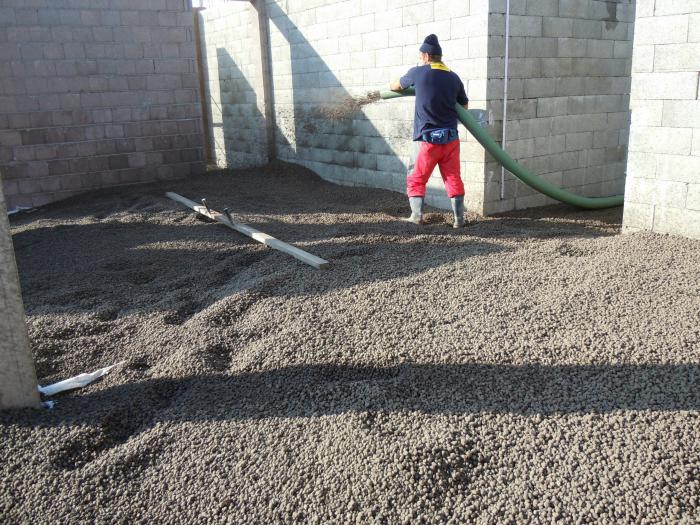

Scope of use
We talked about the fact that expanded clay serves not only for banal floor insulation. It is a versatile material that serves a variety of purposes. There are many options for using expanded clay with the same floor insulation and other surfaces:
- insulation of the floor on the soil with a screed;


- filling the space under the flooring of the boards, when the floor is arranged along the logs;

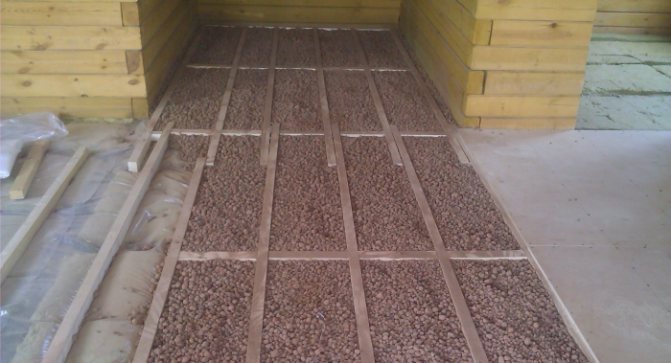
- insulation of the attic floor by filling in the space between the logs and the subsequent finishing of the floor, to protect it from moisture (it is performed both under the screed and along the logs);


- wall insulation by filling the material into a specially prepared box.


These are simple options that do not require any supernatural effort or skill from you. The job is pretty easy if you follow the rules and do it with confidence. Let's look at the technology and methods of floor insulation with expanded clay in a private house.
Floor insulation tips
If the work on floor insulation will be carried out independently, it is necessary to take note of several important recommendations, which are drawn up based on customer feedback:
- Expanded clay is more effective if it is not mixed with concrete. The most effective is a covered pillow made of this material.
- Using a mixture with granules of different sizes, it is possible to achieve a solid layer. It is this criterion that will help to achieve maximum heat retention.
- Expanded clay as floor insulation (reviews were positive) is best used with plastic wrap, which will act as waterproofing.
- For the evenness of the floor, all installation work is carried out along the beacons. They are fixed with alabaster or cement.It is necessary to wait until it dries completely and only then fill up the insulating material and level it.
- In order to exclude the occurrence of cracks, it is recommended to use a metal mesh, with which the base is reinforced.
- After carrying out work on the floor, you can move around after 5-7 days, but the maximum strength occurs only after a month, after which you can subject the surface to normal loads.

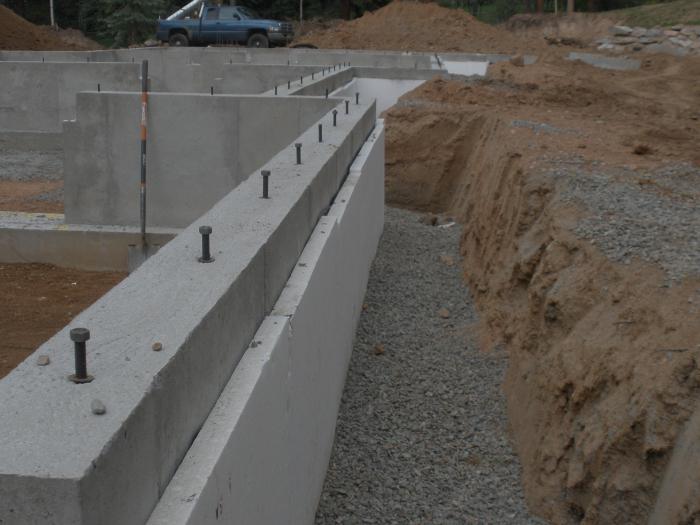
The principle of insulation
Many people know that the most effective thermal insulation material is air. Along with it, there are only inert gas, which almost does not react to the environment. It is this gas that is used to fill the glass unit chamber. However, for building structures (floor, walls, ceiling) you cannot use it in any way, since you need absolute tightness.
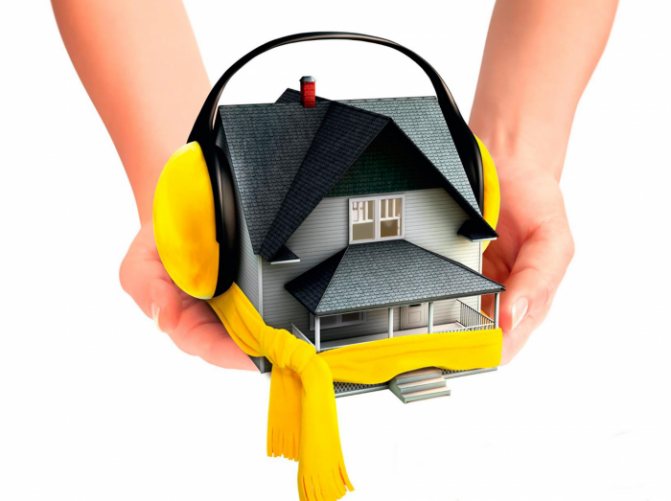

Almost all materials for thermal insulation have a porous structure. Due to this, there is air in the pores, which inhibits heat loss. There is a certain pattern: a less dense material has better thermal insulation properties than a dense one. The lower the density, the better the insulation.
All heaters can be divided into several types:
- roll;
- slab;
- bulk;
- sprayed.
The most budgetary is the sprayed type of insulation, which includes expanded clay. The fact is that this type of material has practically the lowest thermal protection rates. But, he can insulate the structure. Why thermal insulation is needed at all? Look at the photo to find out.
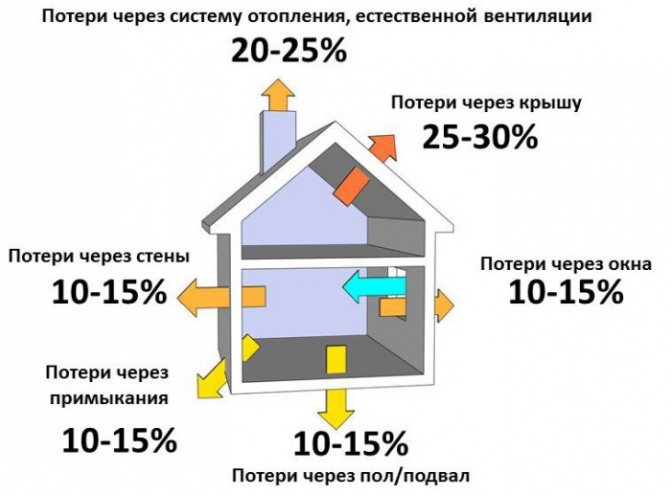

Insulation works solve at least 4 tasks:
- Provide a reduction in waste of the budget for heating the house.
- Protects the structure from condensation, which is a source of mold and mildew.
- They create comfort, warmth and coziness in the house.
- Endow the room with soundproofing properties.
If you do not insulate the house, then its operation will bring you many problems. And what about expanded clay as a heater?
Insulation of roofs
Expanded clay for roof insulation has been used for a long time. Of course, many competing materials have appeared in this area over such a long period, but it has not yet been possible to completely replace the natural material. It is using expanded clay as a heater for the floor (you can see the truthful reviews on the information boards of manufacturing companies) that you can fully judge all its advantages.
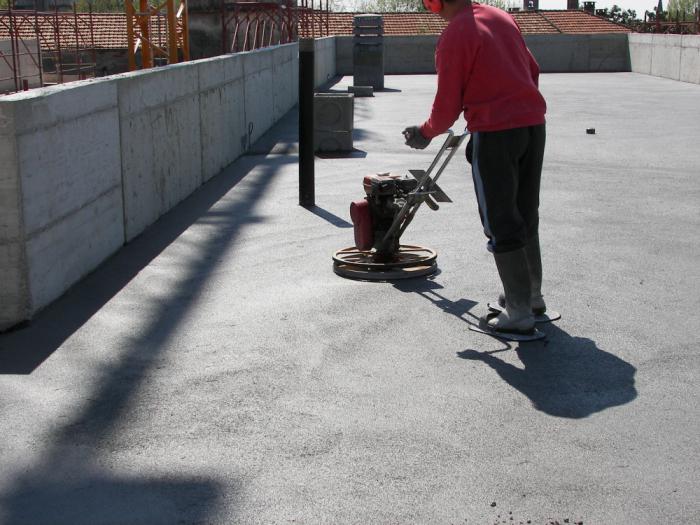

First of all, thanks to this material, it becomes possible to completely eliminate condensate problems. Steam and moisture generation are reduced to zero. Also, importantly, the roof will be protected from leaks for a long time. The low weight of the material will allow you not to spend money on additional strengthening of the foundation. And this is a kind of significant savings. If you involve professionals in the work, then the final result will please the owners not only with warmth and comfort, but for a long time will not require financial investments for reconstruction.
Why is it worth making insulation
Expanded clay concrete is characterized by high strength and durability, so it is excellent for creating residential buildings. It should be noted that the thermal conductivity of the described material is 3 times lower than the thermal conductivity of the brick. But it is worth remembering that it is necessary to make warming of expanded clay concrete house walls. This is due to several reasons:
- To give strength to expanded clay, the material is created very dense, so heat passes through it quickly enough. Because of this, the walls of expanded clay concrete must be insulated from the outside.
- Walls made of the described material are easily destroyed under the influence of external factors. To protect the material, it is worthwhile to make facing and insulate the structure from the outside. Facing bricks are often used for this.
It is worth remembering that wall insulation made of expanded clay concrete blocks will not only help maintain more comfortable conditions in the house, but also prolong its service life, as it protects against condensation in the walls.
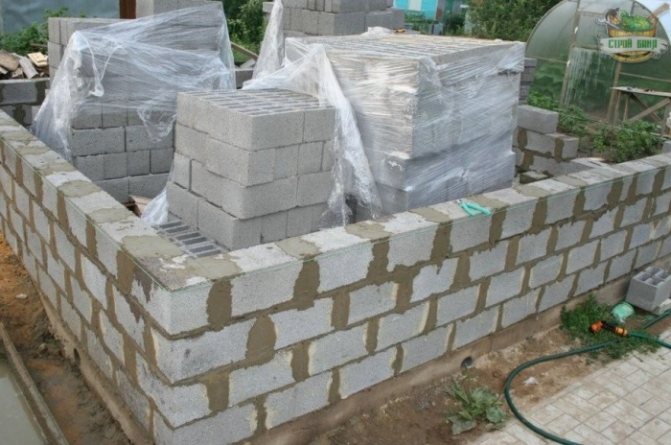

Expanded clay as wall insulation
Feedback from people helps to make the right decision in such a difficult issue as wall insulation with expanded clay. It should be noted right away that this process is quite complicated and time-consuming, as it requires professional knowledge. Sometimes mineral wool is used to simplify such work. However, the advantages of expanded clay significantly distinguish it from other materials. Good ventilation is an important factor. As a rule, this property is simply irreplaceable for enclosed spaces, where a person needs constant air circulation for a comfortable stay.
Using expanded clay as wall insulation, you can face some difficulties, in particular, the threat of being squeezed by other material. Therefore, it is recommended to carry out additional strengthening work in order to avoid such situations. However, this will lead to a significant reduction in the total area of the room. Therefore, it is more cost effective to use other modern materials.


After reviewing the reviews of professionals, we can conclude that expanded clay is ideal for insulating floors and roofs, and for walls it is a rather controversial material.
What materials to use
It is possible to carry out wall insulation from expanded clay concrete blocks using various materials:
- Mineral and basalt wool. This is one of the most popular insulation materials. Its advantages: incombustibility, low thermal conductivity, environmental safety and affordable price. The disadvantage of mineral wool is that it needs additional waterproofing, since it easily absorbs moisture and may become unusable over time. It is produced in the form of slabs and in rolls. The higher the density of the material, the higher the cost.
- Styrofoam. With the help of this lightweight, inexpensive and easy-to-use insulation, work can be done quickly enough, and you can do it yourself. The disadvantages of such a solution include the instability of the material to the action of moisture and pests, fire hazard. Available in the form of slabs.
- Glass wool. Withstands temperature extremes, does not damp and is cheaper than mineral wool. However, when working with the material, safety precautions should be strictly observed - the smallest fibers of glass wool can damage the respiratory tract and skin.

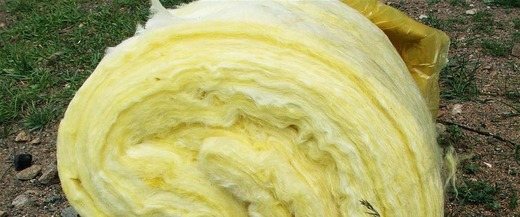
- Penoplex. It has similar characteristics to polystyrene, but it is more expensive and practically impermeable to air. Resistant to rodents, high humidity. It is produced in the form of plates with locks, due to which the process of installing the insulation is simplified as much as possible.
Advice! Answering the question of how to insulate the expanded clay block outside, experienced builders recommend mineral or basalt wool.

